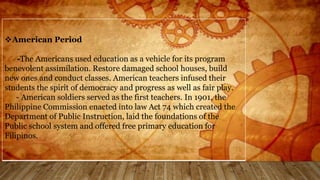Educ 7, midterm ppt
- 1. HISTORICAL FOUNDATIONS OF CURRICULUM IN THE PHILIPPINES
- 2. Pre-Hispanic Period - The objective was basically to promote reverence for, and adoration of Bathala, respect for laws, customs, and authorities represented by parents and elders. - no formal school, - Oral, practical, hands on, Reading, ‘riting, ‘rithmetic (3r’s) Friars - established parochial schools linked with churches to teach catechism to the natives. - goal is to spread Christianity. Religion (Christian Doctrine) – was a compulsory subject at all levels.
- 3. •Education was privileged only to Spanish students. • 19th century – public education for the natives. • Educational decree of 1863 – required the establishment of one primary school for girls and one for boys in each major town of the country. Establishment of the normal school for the training of teachers. Spanish Language – medium of instruction in all schools. • Absence of systematic government supervision of the schools. Over emphasis on religion. Limited and Irrelevant Curriculum •Lack of trained teachers (150 teacher-missionaries to instruct over half a million inhabitants) •Obsolete Teaching Methods. • Poor classroom facilities, Inadequate instructional materials. Racial discrimination against Filipino students. •Absence of academic freedom
- 4. Spanish Period - During the Spanish period and by virtue of Educational Decree of 1863 free public school system was established. There was one school for boys and another school for girls in every municipality. - The Spanish missionaries served as teachers. The same Decree provided for a normal school run by the Jesuits to educate male teachers in Manila. So, it was the Spaniards who started training teachers in normal schools.
- 5. The curriculum created focused on their version of 3R’s: Reading, writing and religion. The main reading materials were all religion-based because the schools are managed by the convents and religious organization.
- 6. American Period -The Americans used education as a vehicle for its program benevolent assimilation. Restore damaged school houses, build new ones and conduct classes. American teachers infused their students the spirit of democracy and progress as well as fair play. - American soldiers served as the first teachers. In 1901, the Philippine Commission enacted into law Act 74 which created the Department of Public Instruction, laid the foundations of the Public school system and offered free primary education for Filipinos.
- 7. The Philippine Commission authorized the Secretary of Public Instruction to bring to the Philippines 600 teachers from USA due to the shortage of teachers. They were the Thomasites. The Curriculum was based on American Traditions and hierarchy. English became the major of instruction.
- 8. Japanese Period - The curriculum was changed because they introduced Nihongo and they abolish English as a medium of instruction and as a subject. The school calendar became longer and no summer vacation for both students and teachers. They promote vocational education The six basic Principles in Japanese education put importance to the diffusion of elementary education and to the promotion of vocational education and Inspire the people with the spirit of love and labor.
- 9. Martial Period - The Department of Education became the Department of Education and Culture in 1972, the Ministry of Education and Culture in 1978, and with the Education Act of 1982, the Ministry of Education, Culture, and Sports. • A bilingual education scheme was established in 1974, requiring Filipino and English to be used in schools. • Science and math subjects as well as English language and literature classes were taught in English while the rest were taught in Filipino.
- 10. • From 1986 to the present • The bilingual policy in education was reiterated in the 1987 Constitution of the Philippines. • (EDCOM), Congress passed Republic Act 7722 and Republic Act 7796 in 1994, creating the Commission on Higher Education (CHED) and the Technical Education and Skills Development Authority (TESDA). The institute governing basic education was thus renamed in 2001 as the Department of Education (DepEd).
- 11. The Philippine Basic Education K-12 - The K-12 program has a so-called “Phased Implementation”, which started in S.Y. 2011- 2012. K-12 curriculum. These are the grades from kindergarten (K) and the 1st grade up to grade 12 (1- 12). The K-12 curriculum allows the students to choose from different tracks such as Academic track, vocational track, sports, and arts
- 12. End of Slides!!! Prepared by: Alexil L. Embac BSED-ENGLISH II











